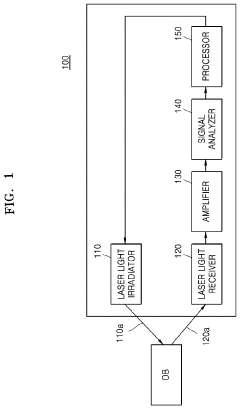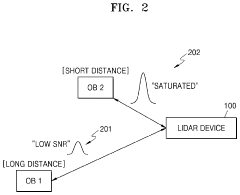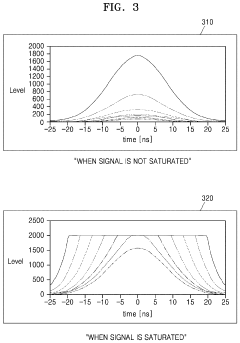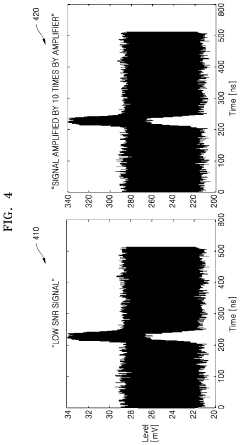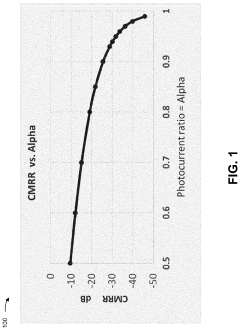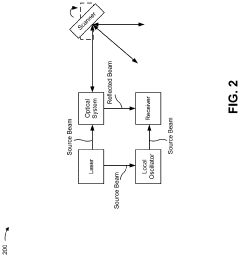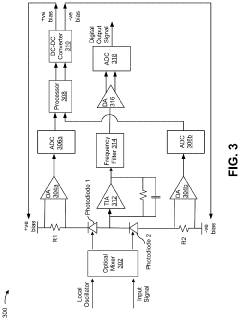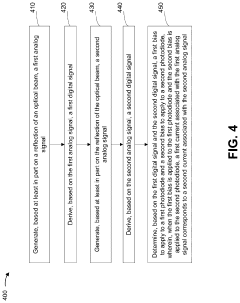Low-Noise Receiver Design For Metasurface LiDAR Systems
SEP 1, 202510 MIN READ
Generate Your Research Report Instantly with AI Agent
Patsnap Eureka helps you evaluate technical feasibility & market potential.
Metasurface LiDAR Receiver Technology Background and Objectives
Metasurface LiDAR technology represents a significant advancement in the field of light detection and ranging systems, evolving from traditional LiDAR technologies that have been in development since the 1960s. The integration of metasurfaces—engineered surfaces with sub-wavelength structures that can manipulate electromagnetic waves—into LiDAR systems has opened new frontiers in sensing capabilities, particularly for autonomous vehicles, robotics, and advanced surveillance systems.
The evolution of LiDAR technology has progressed from simple time-of-flight measurements to sophisticated 3D mapping systems. Traditional LiDAR systems faced limitations in terms of size, cost, power consumption, and scanning capabilities. The introduction of solid-state LiDAR represented a significant step forward, eliminating mechanical moving parts and improving reliability. Metasurface technology now promises to further revolutionize this field by enabling unprecedented control over light manipulation at the nanoscale.
Metasurfaces can be designed to perform complex optical functions such as beam steering, focusing, and wavefront shaping with exceptional precision. When applied to LiDAR receivers, these capabilities translate to enhanced signal collection, improved signal-to-noise ratios, and more accurate target detection and ranging. The fundamental principle involves using arrays of subwavelength optical resonators to modify the phase, amplitude, and polarization of incident light in ways that conventional optics cannot achieve.
The primary technical objective in metasurface LiDAR receiver design is to develop low-noise reception systems that can detect extremely weak return signals while maintaining high spatial resolution and operational range. This involves addressing several interconnected challenges: minimizing thermal noise, reducing shot noise from ambient light, optimizing quantum efficiency of photodetectors, and implementing effective signal processing algorithms.
Current research trends indicate a growing focus on integrating metasurface technology with advanced semiconductor materials and novel photodetection mechanisms. Silicon photonics, III-V compound semiconductors, and quantum dot technologies are being explored as potential platforms for next-generation metasurface LiDAR receivers. Additionally, there is significant interest in developing metasurfaces that can operate across multiple wavelengths simultaneously, enabling more robust environmental sensing under varying conditions.
The ultimate goal of metasurface LiDAR receiver technology is to achieve systems that offer superior performance metrics—including detection range, angular resolution, and point cloud density—while simultaneously reducing size, weight, power consumption, and manufacturing costs. This would enable widespread adoption across various industries and applications, from consumer electronics to industrial automation and defense systems.
As the technology continues to mature, we anticipate breakthrough developments in areas such as dynamic reconfigurable metasurfaces, which could adapt their properties in real-time based on environmental conditions or specific sensing requirements, further enhancing the capabilities and versatility of next-generation LiDAR systems.
The evolution of LiDAR technology has progressed from simple time-of-flight measurements to sophisticated 3D mapping systems. Traditional LiDAR systems faced limitations in terms of size, cost, power consumption, and scanning capabilities. The introduction of solid-state LiDAR represented a significant step forward, eliminating mechanical moving parts and improving reliability. Metasurface technology now promises to further revolutionize this field by enabling unprecedented control over light manipulation at the nanoscale.
Metasurfaces can be designed to perform complex optical functions such as beam steering, focusing, and wavefront shaping with exceptional precision. When applied to LiDAR receivers, these capabilities translate to enhanced signal collection, improved signal-to-noise ratios, and more accurate target detection and ranging. The fundamental principle involves using arrays of subwavelength optical resonators to modify the phase, amplitude, and polarization of incident light in ways that conventional optics cannot achieve.
The primary technical objective in metasurface LiDAR receiver design is to develop low-noise reception systems that can detect extremely weak return signals while maintaining high spatial resolution and operational range. This involves addressing several interconnected challenges: minimizing thermal noise, reducing shot noise from ambient light, optimizing quantum efficiency of photodetectors, and implementing effective signal processing algorithms.
Current research trends indicate a growing focus on integrating metasurface technology with advanced semiconductor materials and novel photodetection mechanisms. Silicon photonics, III-V compound semiconductors, and quantum dot technologies are being explored as potential platforms for next-generation metasurface LiDAR receivers. Additionally, there is significant interest in developing metasurfaces that can operate across multiple wavelengths simultaneously, enabling more robust environmental sensing under varying conditions.
The ultimate goal of metasurface LiDAR receiver technology is to achieve systems that offer superior performance metrics—including detection range, angular resolution, and point cloud density—while simultaneously reducing size, weight, power consumption, and manufacturing costs. This would enable widespread adoption across various industries and applications, from consumer electronics to industrial automation and defense systems.
As the technology continues to mature, we anticipate breakthrough developments in areas such as dynamic reconfigurable metasurfaces, which could adapt their properties in real-time based on environmental conditions or specific sensing requirements, further enhancing the capabilities and versatility of next-generation LiDAR systems.
Market Analysis for Low-Noise LiDAR Systems
The global LiDAR market is experiencing robust growth, projected to reach $3.8 billion by 2025 with a CAGR of 34.0% from 2020. Low-noise LiDAR systems represent a significant segment within this market, driven by increasing demands for higher precision in autonomous vehicles, robotics, and industrial automation applications. The metasurface-based LiDAR systems, featuring advanced low-noise receivers, are positioned to capture substantial market share due to their superior performance characteristics.
Automotive applications currently dominate the market demand for low-noise LiDAR systems, accounting for approximately 40% of the total market. The push toward Level 3-5 autonomous driving capabilities has intensified the need for LiDAR systems capable of accurate detection in adverse weather and lighting conditions, where low-noise receivers provide a critical competitive advantage.
Consumer electronics represents the fastest-growing segment for metasurface LiDAR technology, with projected growth rates exceeding 45% annually. Applications in smartphones, tablets, and AR/VR devices are creating new market opportunities for miniaturized, energy-efficient low-noise LiDAR systems.
Regional analysis indicates North America leads the market with 38% share, followed by Europe (29%) and Asia-Pacific (26%). China is emerging as the fastest-growing market, with domestic LiDAR manufacturers rapidly advancing their low-noise receiver technologies to compete with established Western companies.
Market penetration analysis reveals that while conventional LiDAR systems have reached maturity in certain sectors, metasurface-based systems with low-noise receivers are still in the early adoption phase, currently capturing only 12% of the total LiDAR market. This presents significant growth potential as the technology matures and production costs decrease.
Customer segmentation shows distinct requirements across different industries. Automotive manufacturers prioritize reliability and performance in adverse conditions, while consumer electronics companies emphasize size and power efficiency. Industrial automation customers focus on precision and durability, creating diverse market opportunities for specialized low-noise receiver designs.
Price sensitivity analysis indicates that while current metasurface LiDAR systems command premium pricing (typically 30-40% higher than conventional systems), the price elasticity is high, suggesting that cost reductions could dramatically accelerate adoption rates. Manufacturing economies of scale are expected to reduce costs by approximately 25% annually over the next three years.
Market barriers include high initial development costs, technical complexity in manufacturing metasurfaces at scale, and competition from alternative sensing technologies such as radar and camera-based systems. However, the unique performance advantages of low-noise metasurface LiDAR receivers, particularly in challenging environmental conditions, provide a sustainable competitive edge that will likely drive continued market expansion.
Automotive applications currently dominate the market demand for low-noise LiDAR systems, accounting for approximately 40% of the total market. The push toward Level 3-5 autonomous driving capabilities has intensified the need for LiDAR systems capable of accurate detection in adverse weather and lighting conditions, where low-noise receivers provide a critical competitive advantage.
Consumer electronics represents the fastest-growing segment for metasurface LiDAR technology, with projected growth rates exceeding 45% annually. Applications in smartphones, tablets, and AR/VR devices are creating new market opportunities for miniaturized, energy-efficient low-noise LiDAR systems.
Regional analysis indicates North America leads the market with 38% share, followed by Europe (29%) and Asia-Pacific (26%). China is emerging as the fastest-growing market, with domestic LiDAR manufacturers rapidly advancing their low-noise receiver technologies to compete with established Western companies.
Market penetration analysis reveals that while conventional LiDAR systems have reached maturity in certain sectors, metasurface-based systems with low-noise receivers are still in the early adoption phase, currently capturing only 12% of the total LiDAR market. This presents significant growth potential as the technology matures and production costs decrease.
Customer segmentation shows distinct requirements across different industries. Automotive manufacturers prioritize reliability and performance in adverse conditions, while consumer electronics companies emphasize size and power efficiency. Industrial automation customers focus on precision and durability, creating diverse market opportunities for specialized low-noise receiver designs.
Price sensitivity analysis indicates that while current metasurface LiDAR systems command premium pricing (typically 30-40% higher than conventional systems), the price elasticity is high, suggesting that cost reductions could dramatically accelerate adoption rates. Manufacturing economies of scale are expected to reduce costs by approximately 25% annually over the next three years.
Market barriers include high initial development costs, technical complexity in manufacturing metasurfaces at scale, and competition from alternative sensing technologies such as radar and camera-based systems. However, the unique performance advantages of low-noise metasurface LiDAR receivers, particularly in challenging environmental conditions, provide a sustainable competitive edge that will likely drive continued market expansion.
Current Challenges in Metasurface LiDAR Receiver Design
Metasurface LiDAR systems represent a significant advancement in sensing technology, yet their receiver design faces substantial challenges that impede optimal performance. The integration of metasurfaces with traditional LiDAR architecture introduces complex signal processing requirements that conventional receiver designs struggle to accommodate. Current receivers exhibit insufficient sensitivity to detect the weak return signals from metasurface-modified light pulses, particularly in adverse environmental conditions or when targeting distant or low-reflectivity objects.
Signal-to-noise ratio (SNR) degradation remains a critical issue, with thermal noise, shot noise, and ambient light interference collectively compromising detection accuracy. The miniaturized nature of metasurface components creates thermal management challenges, as heat dissipation in compact receiver designs can lead to performance drift and reduced reliability. Additionally, the unique spectral characteristics of metasurface-modified signals require specialized filtering techniques that current designs have not fully optimized.
Bandwidth limitations present another significant obstacle. Metasurface LiDAR systems often operate with ultra-short pulses or complex modulation schemes that demand receivers with exceptional temporal resolution and wide bandwidth capabilities. Current receiver architectures frequently exhibit bandwidth constraints that restrict the full exploitation of metasurface capabilities, particularly in high-resolution imaging applications.
Power consumption efficiency remains suboptimal in existing designs, with high-sensitivity receivers typically requiring substantial power that limits deployment in portable or energy-constrained applications. This challenge is particularly acute for autonomous vehicle implementations, where energy efficiency directly impacts operational range and system viability.
Manufacturing complexity and cost factors also impede widespread adoption. The precise alignment requirements between metasurface elements and receiver components demand sophisticated fabrication techniques that increase production costs and reduce yield rates. Current manufacturing processes struggle to maintain the necessary tolerances at scale, creating a barrier to mass production.
Integration challenges with existing signal processing pipelines further complicate implementation. Many current receiver designs generate output signals that require substantial post-processing, introducing latency that compromises real-time performance in dynamic environments. The lack of standardized interfaces between metasurface receivers and downstream processing systems necessitates custom integration solutions for each application scenario.
Weather resilience represents a persistent challenge, with current receiver designs showing performance degradation in rain, fog, or snow conditions. The unique light-matter interactions created by metasurfaces can be particularly susceptible to atmospheric disturbances, requiring advanced compensation techniques that have not been fully developed in existing receiver architectures.
Signal-to-noise ratio (SNR) degradation remains a critical issue, with thermal noise, shot noise, and ambient light interference collectively compromising detection accuracy. The miniaturized nature of metasurface components creates thermal management challenges, as heat dissipation in compact receiver designs can lead to performance drift and reduced reliability. Additionally, the unique spectral characteristics of metasurface-modified signals require specialized filtering techniques that current designs have not fully optimized.
Bandwidth limitations present another significant obstacle. Metasurface LiDAR systems often operate with ultra-short pulses or complex modulation schemes that demand receivers with exceptional temporal resolution and wide bandwidth capabilities. Current receiver architectures frequently exhibit bandwidth constraints that restrict the full exploitation of metasurface capabilities, particularly in high-resolution imaging applications.
Power consumption efficiency remains suboptimal in existing designs, with high-sensitivity receivers typically requiring substantial power that limits deployment in portable or energy-constrained applications. This challenge is particularly acute for autonomous vehicle implementations, where energy efficiency directly impacts operational range and system viability.
Manufacturing complexity and cost factors also impede widespread adoption. The precise alignment requirements between metasurface elements and receiver components demand sophisticated fabrication techniques that increase production costs and reduce yield rates. Current manufacturing processes struggle to maintain the necessary tolerances at scale, creating a barrier to mass production.
Integration challenges with existing signal processing pipelines further complicate implementation. Many current receiver designs generate output signals that require substantial post-processing, introducing latency that compromises real-time performance in dynamic environments. The lack of standardized interfaces between metasurface receivers and downstream processing systems necessitates custom integration solutions for each application scenario.
Weather resilience represents a persistent challenge, with current receiver designs showing performance degradation in rain, fog, or snow conditions. The unique light-matter interactions created by metasurfaces can be particularly susceptible to atmospheric disturbances, requiring advanced compensation techniques that have not been fully developed in existing receiver architectures.
State-of-the-Art Low-Noise Receiver Solutions
01 Noise reduction circuit designs
Various circuit designs can be implemented to reduce noise in receivers. These include specialized amplifier configurations, feedback mechanisms, and filtering circuits that minimize unwanted signal interference. These designs focus on optimizing the signal-to-noise ratio by addressing noise at the circuit level, resulting in cleaner signal reception and processing.- Noise reduction techniques in receiver circuits: Various circuit design techniques can be employed to reduce noise in receivers. These include the use of low-noise amplifiers (LNAs), noise-cancellation circuits, and specialized filtering methods. By implementing these techniques, the signal-to-noise ratio can be improved, resulting in better reception quality and increased sensitivity of the receiver.
- Adaptive noise suppression in wireless receivers: Adaptive noise suppression systems can dynamically adjust to changing noise conditions in wireless communication environments. These systems use algorithms to detect and characterize noise patterns, then apply appropriate filtering or cancellation techniques. This approach is particularly effective in mobile devices that operate across varying signal environments and interference conditions.
- Integrated circuit design for noise minimization: Specialized integrated circuit designs can significantly reduce receiver noise. These designs incorporate careful layout techniques, shielding structures, and optimized component placement to minimize electromagnetic interference and thermal noise. Advanced semiconductor processes and materials are also utilized to create low-noise components that improve overall receiver performance.
- Testing and measurement of receiver noise: Accurate testing and measurement methods are essential for characterizing and reducing receiver noise. These methods include specialized test equipment and procedures for measuring noise figure, signal-to-noise ratio, and other relevant parameters. By precisely quantifying noise performance, engineers can identify problem areas and validate the effectiveness of noise reduction techniques.
- Power management for noise reduction: Effective power management strategies can significantly reduce noise in receiver circuits. These include techniques for minimizing power supply noise, optimizing bias conditions, and implementing low-power operating modes. By carefully controlling power distribution and consumption, unwanted noise sources can be minimized while maintaining receiver performance and extending battery life in portable devices.
02 Low-noise amplifier (LNA) technologies
Low-noise amplifiers are critical components in receiver systems that amplify weak signals while adding minimal noise. Advanced LNA designs incorporate techniques such as noise matching, optimized transistor biasing, and specialized topologies to achieve lower noise figures. These technologies are particularly important in wireless communication systems where signal integrity is paramount.Expand Specific Solutions03 Adaptive noise cancellation techniques
Adaptive systems can dynamically adjust to changing noise conditions in receiver environments. These techniques employ algorithms that identify noise patterns and generate inverse signals to cancel unwanted noise components. By continuously monitoring and adapting to the noise environment, these systems maintain optimal performance across varying operating conditions.Expand Specific Solutions04 Noise testing and measurement methods
Specialized testing methodologies allow for accurate characterization of receiver noise performance. These include noise figure measurements, signal-to-noise ratio analysis, and interference testing protocols. By quantifying noise parameters, engineers can validate design improvements and ensure receivers meet performance specifications under various operating conditions.Expand Specific Solutions05 Digital signal processing for noise reduction
Digital processing techniques can be applied to received signals to minimize noise effects after analog-to-digital conversion. These methods include digital filtering, statistical noise reduction algorithms, and advanced signal reconstruction techniques. By processing signals in the digital domain, more sophisticated noise reduction strategies can be implemented without the limitations of analog components.Expand Specific Solutions
Key Industry Players in Metasurface LiDAR Development
The metasurface LiDAR receiver market is in an early growth phase, characterized by rapid technological innovation and expanding applications in autonomous vehicles and robotics. Market size is projected to grow significantly as LiDAR systems become essential for advanced sensing applications. Technologically, companies are at varying maturity levels: established players like Qualcomm, Apple, and Analog Devices bring semiconductor expertise; specialized LiDAR manufacturers including RoboSense, Hesai, and Ibeo focus on system integration; while emerging innovators like Lumotive and Analog Photonics lead in metasurface technology specifically. Academic-industry partnerships with institutions like the University of Alicante and Chinese Academy of Sciences are accelerating development of low-noise receiver designs that overcome traditional performance limitations in range, resolution, and interference rejection.
Hesai Technology Co. Ltd.
Technical Solution: Hesai has developed a sophisticated low-noise receiver design for their metasurface LiDAR systems that focuses on achieving superior performance in challenging environmental conditions. Their receiver architecture employs a proprietary APD (Avalanche Photodiode) array with individually optimized gain settings that maximize sensitivity while maintaining low noise characteristics. Hesai's design incorporates a multi-stage amplification chain with carefully balanced noise contribution at each stage, resulting in an optimized noise figure across the entire signal path. Their receiver includes advanced digital signal processing algorithms that perform real-time noise filtering and signal enhancement, enabling reliable detection even with low return signal strengths. A key innovation in Hesai's approach is their hybrid analog-digital architecture that performs initial signal conditioning in the analog domain before conversion, preserving signal integrity while minimizing quantization noise effects. Their receiver design also features specialized optical filtering elements that effectively reject ambient light interference while maintaining high quantum efficiency for the laser wavelength used in their system, significantly improving the signal-to-noise ratio in outdoor applications.
Strengths: Exceptional performance in adverse weather conditions due to advanced signal processing algorithms and optimized optical design. Highly scalable architecture that can be adapted to different performance tiers and application requirements. Weaknesses: Higher component cost compared to simpler receiver designs, potentially limiting adoption in cost-sensitive applications.
QUALCOMM, Inc.
Technical Solution: Qualcomm has developed an innovative low-noise receiver architecture for metasurface LiDAR systems that leverages their expertise in RF and mixed-signal design. Their solution integrates a specialized RF front-end with their Snapdragon automotive platforms, creating a comprehensive system-on-chip approach to LiDAR signal processing. The receiver design incorporates a custom-designed avalanche photodiode (APD) array with integrated quenching circuits that optimize sensitivity while minimizing dark current noise. Qualcomm's architecture employs a multi-stage noise cancellation technique that combines both analog and digital filtering to achieve superior signal extraction in challenging ambient light conditions. Their receiver includes adaptive threshold detection algorithms implemented directly in hardware, allowing for real-time adjustment to varying signal strengths and environmental factors. The design also features sophisticated clock and data recovery circuits that maintain timing precision even with weak return signals, enabling accurate distance measurements at extended ranges and with low-reflectivity targets.
Strengths: Highly integrated SoC approach reduces system complexity and power consumption while enabling advanced signal processing capabilities. Leverages Qualcomm's extensive experience in RF noise management from cellular technologies. Weaknesses: Relatively new entrant to the LiDAR market compared to specialized LiDAR companies, potentially limiting application-specific optimization experience.
Critical Patents and Research in Metasurface LiDAR Receivers
Lidar device and operating method thereof
PatentPendingUS20240085537A1
Innovation
- A LiDAR device with a processor that adjusts the dynamic range of an analog-to-digital converter (ADC) to sample pulsed laser reflected light signals, reducing the dynamic range to ¼ of the reference range for low SNR signals, allowing for valid signal detection and subsequent restoration to the reference range after sampling is complete, thereby improving signal sampling accuracy.
Light detection and ranging receiver with avalanche photodiodes
PatentActiveUS12013495B2
Innovation
- A lidar system using a pair of avalanche photodiodes with a processor to determine and apply biases to balance photocurrents, achieving a common mode rejection ratio (CMRR) near one, thereby improving SNR without additional noise generation.
Safety Standards and Regulatory Compliance
The integration of metasurface LiDAR systems into commercial and industrial applications necessitates strict adherence to established safety standards and regulatory frameworks. These systems, particularly those employing low-noise receivers, must comply with multiple layers of regulations that govern both laser emissions and electromagnetic compatibility.
International laser safety standards, including IEC 60825 and ANSI Z136.1, establish critical classification systems for laser products based on their potential hazards. Metasurface LiDAR systems typically fall under Class 1 or Class 1M categories, requiring comprehensive risk assessments and implementation of appropriate safety measures. The low-noise receiver design must incorporate fail-safe mechanisms that prevent laser emissions from exceeding permissible exposure limits under any operational or fault conditions.
Electromagnetic compatibility (EMC) regulations, such as FCC Part 15 in the United States and the EMC Directive 2014/30/EU in Europe, impose strict requirements on electronic systems. Low-noise receivers in metasurface LiDAR must demonstrate immunity to external electromagnetic interference while simultaneously limiting their own emissions. This dual requirement presents significant design challenges, particularly in maintaining signal integrity while complying with regulatory thresholds.
Automotive applications of metasurface LiDAR systems face additional regulatory scrutiny. Standards like ISO 26262 for functional safety and UN Regulation No. 10 for EMC in vehicles establish stringent requirements for systems integrated into road vehicles. The low-noise receiver design must demonstrate resilience against environmental stressors while maintaining consistent performance across the vehicle's operational lifetime.
Eye safety considerations represent a paramount concern for LiDAR systems. The low-noise receiver design must work in concert with appropriate optical filtering and power management systems to ensure that even under failure conditions, the system cannot emit radiation at levels harmful to human vision. This often necessitates redundant safety mechanisms and comprehensive failure mode analysis.
Privacy regulations increasingly impact LiDAR deployment, particularly in public spaces. While primarily focused on data processing rather than hardware design, these regulations may influence receiver specifications, particularly regarding resolution capabilities and data capture parameters. System designers must consider these regulatory constraints during the initial architecture phase.
Certification processes for metasurface LiDAR systems typically involve extensive documentation, laboratory testing, and in some cases, field trials. The low-noise receiver design must be thoroughly characterized across its operational envelope, with particular attention to edge cases and potential failure modes. Manufacturers must maintain detailed technical files demonstrating compliance with all applicable standards.
International laser safety standards, including IEC 60825 and ANSI Z136.1, establish critical classification systems for laser products based on their potential hazards. Metasurface LiDAR systems typically fall under Class 1 or Class 1M categories, requiring comprehensive risk assessments and implementation of appropriate safety measures. The low-noise receiver design must incorporate fail-safe mechanisms that prevent laser emissions from exceeding permissible exposure limits under any operational or fault conditions.
Electromagnetic compatibility (EMC) regulations, such as FCC Part 15 in the United States and the EMC Directive 2014/30/EU in Europe, impose strict requirements on electronic systems. Low-noise receivers in metasurface LiDAR must demonstrate immunity to external electromagnetic interference while simultaneously limiting their own emissions. This dual requirement presents significant design challenges, particularly in maintaining signal integrity while complying with regulatory thresholds.
Automotive applications of metasurface LiDAR systems face additional regulatory scrutiny. Standards like ISO 26262 for functional safety and UN Regulation No. 10 for EMC in vehicles establish stringent requirements for systems integrated into road vehicles. The low-noise receiver design must demonstrate resilience against environmental stressors while maintaining consistent performance across the vehicle's operational lifetime.
Eye safety considerations represent a paramount concern for LiDAR systems. The low-noise receiver design must work in concert with appropriate optical filtering and power management systems to ensure that even under failure conditions, the system cannot emit radiation at levels harmful to human vision. This often necessitates redundant safety mechanisms and comprehensive failure mode analysis.
Privacy regulations increasingly impact LiDAR deployment, particularly in public spaces. While primarily focused on data processing rather than hardware design, these regulations may influence receiver specifications, particularly regarding resolution capabilities and data capture parameters. System designers must consider these regulatory constraints during the initial architecture phase.
Certification processes for metasurface LiDAR systems typically involve extensive documentation, laboratory testing, and in some cases, field trials. The low-noise receiver design must be thoroughly characterized across its operational envelope, with particular attention to edge cases and potential failure modes. Manufacturers must maintain detailed technical files demonstrating compliance with all applicable standards.
Integration Strategies with Autonomous Systems
The integration of metasurface LiDAR systems with autonomous vehicles, drones, and robotics platforms represents a critical advancement in sensing technology deployment. Low-noise receiver designs specifically engineered for these applications must address the unique operational requirements of autonomous systems, including real-time processing capabilities, environmental adaptability, and system-level integration constraints.
Autonomous vehicles require seamless integration of metasurface LiDAR receivers with existing sensor fusion architectures. This necessitates standardized data interfaces and synchronization protocols to ensure temporal alignment with radar, camera, and ultrasonic sensor data. The low-noise receivers must be designed with automotive-grade reliability standards (AEC-Q100) while maintaining performance integrity under extreme temperature variations (-40°C to 125°C) and vibration conditions common in vehicular applications.
For drone-based implementations, weight and power consumption become paramount considerations. Metasurface LiDAR receivers must be miniaturized without compromising noise performance, typically requiring advanced packaging techniques such as 3D stacking and system-in-package (SiP) approaches. Power management circuits must be co-designed with the receiver architecture to optimize battery life while maintaining detection sensitivity during critical flight operations.
Robotics platforms present unique integration challenges due to their diverse form factors and operational environments. Modular receiver designs with flexible mounting options and standardized communication protocols (SPI, I2C, CAN) facilitate integration across various robotic systems. Additionally, the receivers must incorporate adaptive gain control mechanisms to handle the dynamic lighting conditions encountered during robotic navigation in mixed indoor-outdoor environments.
Software integration represents another critical dimension, requiring well-defined APIs and middleware solutions to incorporate metasurface LiDAR data into autonomous decision-making frameworks. Real-time driver development must account for the unique characteristics of metasurface-based signals, including specialized filtering algorithms to preserve the noise advantages inherent in the receiver design while enabling rapid point cloud generation and object classification.
Field programmable gate arrays (FPGAs) and application-specific integrated circuits (ASICs) offer promising hardware acceleration platforms for low-latency processing of metasurface LiDAR data directly within the receiver module. This edge computing approach minimizes data transfer requirements and enables autonomous systems to make faster decisions based on high-fidelity spatial information, particularly critical for obstacle avoidance and navigation in complex environments.
Autonomous vehicles require seamless integration of metasurface LiDAR receivers with existing sensor fusion architectures. This necessitates standardized data interfaces and synchronization protocols to ensure temporal alignment with radar, camera, and ultrasonic sensor data. The low-noise receivers must be designed with automotive-grade reliability standards (AEC-Q100) while maintaining performance integrity under extreme temperature variations (-40°C to 125°C) and vibration conditions common in vehicular applications.
For drone-based implementations, weight and power consumption become paramount considerations. Metasurface LiDAR receivers must be miniaturized without compromising noise performance, typically requiring advanced packaging techniques such as 3D stacking and system-in-package (SiP) approaches. Power management circuits must be co-designed with the receiver architecture to optimize battery life while maintaining detection sensitivity during critical flight operations.
Robotics platforms present unique integration challenges due to their diverse form factors and operational environments. Modular receiver designs with flexible mounting options and standardized communication protocols (SPI, I2C, CAN) facilitate integration across various robotic systems. Additionally, the receivers must incorporate adaptive gain control mechanisms to handle the dynamic lighting conditions encountered during robotic navigation in mixed indoor-outdoor environments.
Software integration represents another critical dimension, requiring well-defined APIs and middleware solutions to incorporate metasurface LiDAR data into autonomous decision-making frameworks. Real-time driver development must account for the unique characteristics of metasurface-based signals, including specialized filtering algorithms to preserve the noise advantages inherent in the receiver design while enabling rapid point cloud generation and object classification.
Field programmable gate arrays (FPGAs) and application-specific integrated circuits (ASICs) offer promising hardware acceleration platforms for low-latency processing of metasurface LiDAR data directly within the receiver module. This edge computing approach minimizes data transfer requirements and enables autonomous systems to make faster decisions based on high-fidelity spatial information, particularly critical for obstacle avoidance and navigation in complex environments.
Unlock deeper insights with Patsnap Eureka Quick Research — get a full tech report to explore trends and direct your research. Try now!
Generate Your Research Report Instantly with AI Agent
Supercharge your innovation with Patsnap Eureka AI Agent Platform!
